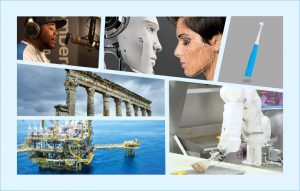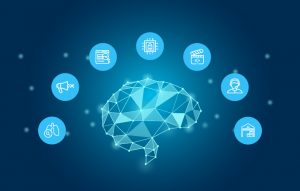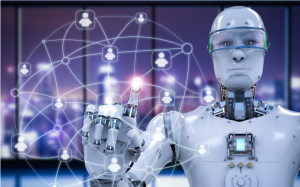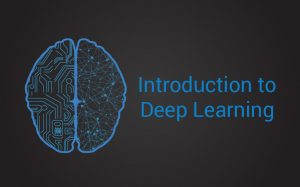IT decision makers believe 75% of enterprise applications will use AI by 2021 – IDC
Deep learning is no more just a fancy term used in the computing industry, instead it is transforming enterprises by generating valuable insights from data gathered through images, videos, text, and audio.
Although the popularity of deep learning (DL) is increasing exponentially, still, a lot of businesses hesitate to implement it in their business processes. This is because either they are unaware of the potential the deep learning applications hold or do not have a right strategy to deploy it.
In this blog post we will discuss the fundamentals of deep learning, how it works, its use cases, and more, which will remove your doubts and help you to decide whether to adopt this technology or not.
What is deep learning?
Deep learning a.k.a deep structured learning or hierarchical learning is a subset of machine learning. DL also uses artificial neural networks to mimic some of the processes that the human brain performs, and uses algorithms with images, text, and speech, to recognize, identify and understand patterns in the data. The purpose of deep learning is to ‘understand’ data on the whole and not be limited to just one task.
How deep learning works
Deep learning is one of the machine learning methods which trains an AI to predict outputs by giving a set of inputs. It can use both supervised and unsupervised learning to train the AI. Generally, a deep learning process consists of two main phases – training and inferring.
The training phase is a process of labeling a massive amount of data and defining their characteristics, in which the neural network architecture memorizes these characteristics to give correct output when needed in the future. During the inferring phase, the deep learning model makes decisions and labels new data using its previous knowledge.
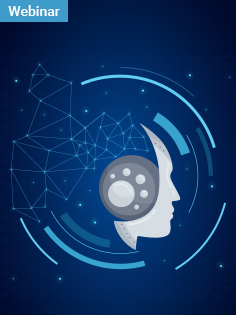
What can you do to stay ahead of competition? Adopt AI. Now.
Webinar agenda
- Characteristics of early AI adopters
- Areas across the business chain where AI can create value
- Essentials of successful AI transformations
- AI use cases
- Demo
A deep learning training process includes multiple stages such as:
- Gather data
- The architecture neural network asks a set of binary false/true questions or extracts numerical values from data blocks
- Classify data as per the answers received and choose the training model
- Label data by matching characteristics
How is deep learning different from machine learning
Basically, machine learning uses algorithms to analyze data, learn from that data, and make data-driven decisions based on what it had learned from that data. On the other hand, in deep learning structures, algorithms in different layers create an “artificial neural network” that can learn and make informed decisions on its own.
Other than that, deep learning needs a huge amount of unlabeled data, high-performance hardware, more time to train the model, as compared to machine learning. Also, DL is capable of performing “holistic learning” and has an end-to-end problem-solving approach. This means that if a machine is fed with raw data and given a task to perform, say, classification, then it will self-learn how to do it automatically.
The biggest difference between both approaches is that deep learning algorithms scale with data, whereas machine learning techniques can perform well up to a certain level.
What are the benefits of deep learning
Deep learning is becoming significant for enterprises because it is an advanced version of machine learning, adapts to new and unstructured data automatically, has progressive learning capabilities, and eliminates unnecessary costs. Let’s check out other benefits that DL has.
- Deep learning algorithms can create new tasks to solve existing tasks with human intervention, which helps data scientists to save a lot of time that they spend working with big data.
- Deep learning also has the ability to learn from unlabeled or unstructured data which brings great potential to create real-world applications using unstructured big data.
- Also, the deep learning models can be applied to a large dataset for knowledge application, knowledge discovery, and knowledge-based prediction which can work as a powerful engine for producing actionable results.
- The total time it takes to train a deep learning model varies drastically, from days to weeks or more than that, and it also depends on various factors such as the available hardware, the size of the dataset, the network architecture, the layers in the neural network, and more.
- In the deep learning training process, a large amount of data is analyzed which leaves very little time for ensuring an efficient training process. Hence, data scientists have to use deep learning algorithms in such a way that neural networks can parse a large amount of continuous data input.
- Many times, it is a big disadvantage that a deep learning application fails to provide a justification to why it has reached a certain conclusion. You cannot identify why your system has decided that it is a picture of Chihuahua and not a muffin. Thus ensuring conclusion transparency is a challenge when you haven’t trained your deep learning systems with enormous data.
- Another issue with deep learning is that it learns through observation which means it will only learn what was in the data fed to them. So if the amount of data is small or it comes from one particular source which is not necessarily speaking in depth, then the model will learn and derive conclusions with that shallow knowledge. This can also lead to biases in deriving a conclusion because the model was trained on data that contains biases.
- Computer vision
- Automatic speech recognition
- Natural language processing
- Visual art processing
- Audio recognition
- Social network filtering
- Machine translation
- Medical image analysis
- Material inspection and more
What are deep learning challenges
Businesses can definitely reap great benefits by labeling unstructured big data and improving the way they process data using deep learning. However, let’s check out some challenges involved in building an accurate deep learning model.
Some of the applications that use deep learning models
These applications can teach themselves to carry out functions such as understanding spoken commands, discovering potential new drugs, identifying objects and faces, sifting through photos and more. A lot of industries are already using these deep learning applications to perform industry-specific processes with greater accuracy.
How is deep learning disrupting various industries
Finance
The majority of financial companies and institutes face challenges in predicting stock market performances, trading prices, and in identifying fraudulent practices. By integrating deep learning model into proprietary systems, a huge amount of data can be processed quickly. Besides, financial institutes can also study the credit history of a customer and determine whether to sanction a loan or not.
Insurance
The insurance industry uses deep learning solutions to manage claims by recognizing fraudulent patterns and identify legitimate claims to disburse payout. Also, by using images of damaged cars, the deep learning model predicts the estimation of repair costs by eliminating the need for a car to visit a garage for assessment.
Healthcare
With the use of deep learning technology, diseases like cancer can be detected early as it suggests timelines for conducting and reviewing scans to check the chances of cancer. Deep learning algorithms can also identify critical parameters that help in predicting hospitalization in case of chronic heart diseases, and diabetes among others.
Customer service
For brands, personalized customer service is more crucial than ever and with deep learning, companies can personalize coupons, offers, and emails to build a strong customer relationship. With deep learning models, the retailer can analyze the previous purchase history and the buying pattern of a customer and provide the right product recommendation.
Manufacturing
Manufacturing is an industry where even the slightest system error or manual lapse can produce faulty products leading to huge losses. By integrating deep neural network with manufacturing assembly lines, an organization can enable systems to produce finished goods rapidly with greater accuracy helping manufacturing unit make more profit.
The final say
By now you must have understood that deep learning is no longer a trend but an important technology to improve operational efficiency, unlock new revenue streams and stay ahead of the competition. Many big brands like Google, Twitter, Facebook, Pinterest, IBM, Apple, Microsoft, PayPal, and more have already adopted a deep learning strategy to offer better products/services. If you are looking for an end-to-end deep learning consulting to decide how to implement it in your business model, talk to our experts.



